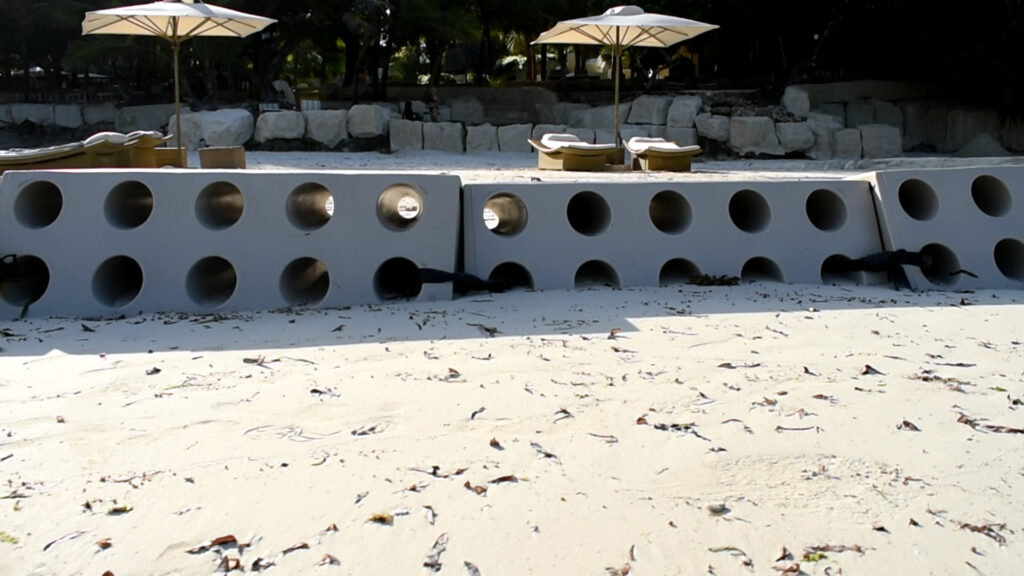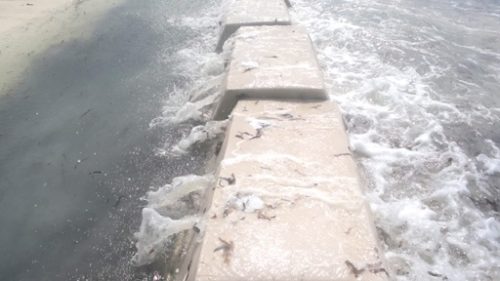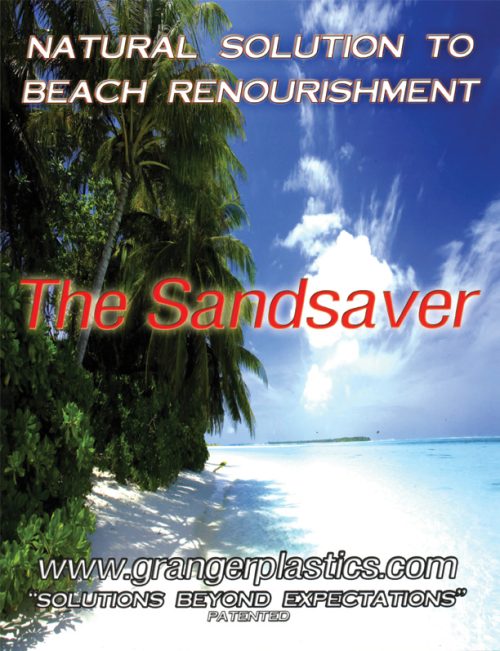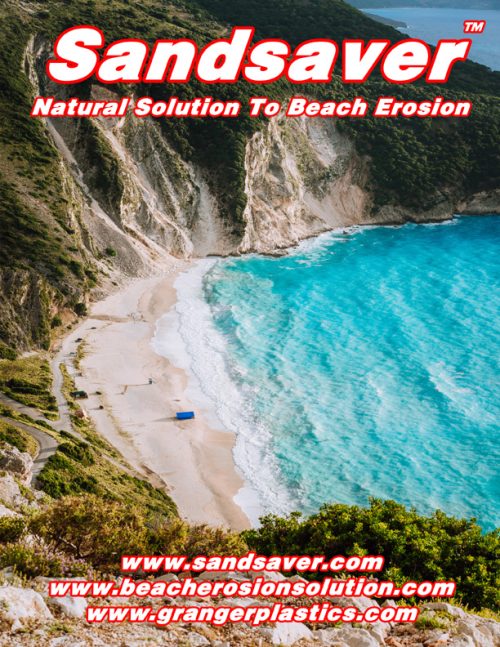
About Sandsaver
The Sandsaver is an innovative solution to beach erosion that surpasses traditional accepted methods. Building upon proven technology, it operates through two mechanisms: first, by breaking down the energy of the surf as waves crash against the modules, and second, by directing sand to the beach side of the module through either the surf activity or the large tapered opening on the surf side. The smaller opening on the beach side allows sand and sediment to settle, increasing the size and profile of the beach. This natural re-nourishment process is far less harmful to local animals, sea life, and the beach ecosystem than historically accepted methods such as beach dredging.

How does sandsaver work to solve beach erosion?
Sandsaver employs a comprehensive approach to safeguarding and restoring beachfront and coastal properties. The installation of modules typically occurs along the low tide line, strategically positioning the larger opening to face the surf, while the smaller opening of the tapered thru hole faces the beach side of the module. Once the module is filled, wave activity crashes against it, enabling sand and wave movement to pass over the modules or through the tapered openings. This facilitates the transportation of sand to the beach side of the module, while the receding surf retreats back into the water, allowing the sand and sediment to settle. Through this repetitive and natural process, the beach is gradually rebuilt, eventually concealing the Sandsaver modules.
Watch the video below for a brief explanation as to how the Sandsaver beach erosion solution works!
Sandsaver beach erosion solution
Beach erosion, my friends, is a global problem that is wreaking havoc on coastal communities all around the world. It’s like a never-ending battle against the forces of nature and the relentless waves. Can you believe that each year, billions of dollars are spent in the United States alone to protect and restore our beloved beaches and coastal properties? It’s a staggering amount!
One of the methods used to combat this issue is beach dredging. This process involves removing sediment and sand from one area and then depositing it onto the beach surface to counteract erosion. Sounds like a great solution, right? Well, here’s the catch – it seems like more and more communities are trapped in a vicious cycle of constantly dredging the beach to replenish the sand, only to watch it wash away into the ocean almost as quickly as it was brought in. It’s like a never-ending cycle of insanity!
But fear not, my friends, for there is hope on the horizon! Introducing Sandsaver, the innovative solution to beach erosion. This groundbreaking technology is here to revolutionize the way we protect our precious coastlines. Want to know more? Well, you’re in luck! Check out the video below to learn all about Sandsaver and how it’s changing the game in the battle against beach erosion.
So, let’s join forces and put an end to this cycle of frustration and wasted resources. Together, we can save our beaches and ensure that future generations can enjoy the beauty and serenity of our coastal communities. Let’s make a difference with Sandsaver!
Sandsaver beach Erosion barrier features
- Sandsaver is the only modular system, that promotes beach accretion, while preventing beach erosion.
- Rotationally Molded from nearly indestructible, Food Grade Polyethylene.
- Does not contain or leech BPA or phtalates into water, land or eco-system.
- Modular design for simple installation, no chains or rebar required.
- Inexpensive and re-usable in comparison to alternative/currently accepted beach restoration methods.
- Sandsaver is molded from Polyethylene, which is 100% recyclable.
- Sandsaver, drastically reduces the carbon footprint of most Beach Restoration projects, by not requiring numerous, gas guzzling Barges.
- Sandsaver, can be re-used multiple times, for multiple installs, in multiple locations, if so desired. Or the system can be left in place permanently.
- Environmentally friendly, will not deteriorate, nor will the units “take in” any Sea Turtles or other living organisms, unlike any type of Dredging barges.
- Each module weighs approximately 5200 pounds when full; Not light weight or easily moved; Tornadoes/Hurricanes would have to have unheard of speeds to move a module due to the weight. Contingent upon the length of the installation, the weight of the system increases drastically.
- Tapered through holes with larger opening exposed closest to surf, for easier transport to beach side of module.
- Will not leave exposed concrete, rocks, wood, or other materials that could be potentially dangerous to those utilizing the beach, alleviating those safety concerns.
- Modular system allows for as much or as little Beach re-nourishment as needed.
- Protected by US and International Patents
- Proudly manufactured in the United States of America.
Sandsaver and the rotomolding process
The Sandsaver, a patented product by the renowned rotational moulding leader, Granger Plastics Company, is a true testament to its durability. The rotomolding process ensures that the Sandsaver is incredibly strong, as it undergoes minimal stress during manufacturing. This strength is vital in enabling the Sandsaver to withstand the harshest of conditions, including Mother Nature’s relentless elements, unpredictable weather, and the relentless power of waves. Witness the remarkable durability of the rotationally molded Sandsaver products in the video below, as they effortlessly withstand various surf activities and effectively combat beach erosion.
Get ready to be blown away by the incredible durability of plastic products created through the revolutionary rotational molding process! From playground equipment to agricultural tanks and even tornado shelters, these items are built to withstand the test of time. What makes this manufacturing process so unique is its ability to create products without subjecting them to any unnecessary stress. If you’re curious to learn more about the fascinating world of rotational molding, click here and dive into the process that’s changing the game!
Sandsaver installs
The Sandsaver has been put to the test in all sorts of surf and tide situations, and it has come out on top every time. Whether it’s dealing with calm waters in the Gulf of Mexico or tackling the powerful waves of the Indian Ocean, the Sandsaver has proven itself as the ultimate solution for beach renourishment. If you want to dive deeper into the success stories of the Sandsaver Beach Erosion Solution Installations, just click on the links below and prepare to be amazed!
Sandsaver information
Click below to download Sandsaver PDF Files
Additional Sandsaver beach erosion solution information
Click any of the links below to learn additional details about the Sandsaver natural solution to beach erosion.


